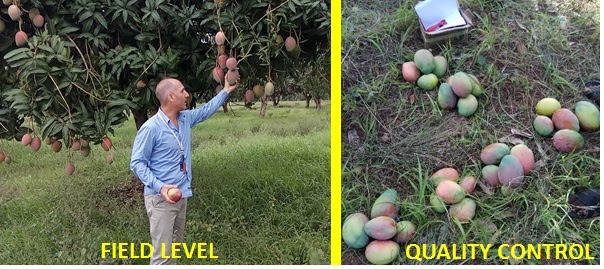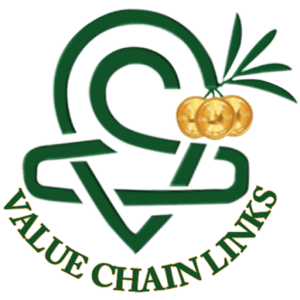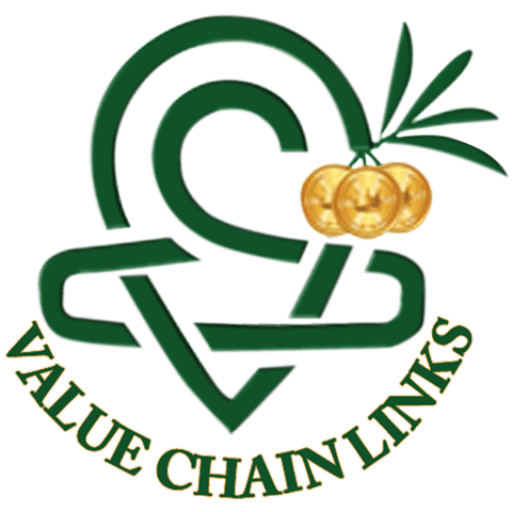ARE WE RICH ENOUGH TO MARKET LOW-QUALITY AGRO-PRODUCE?

BY
DR. NIMROD
It was November 15th, 1988; I have just finished four years of army service and was on my way back to the Kibbutz’s fruits orchards.
Soon, I become the one in charge of crop protection, including executing the sprays by myself and the harvest manager of 1000 tons, which includes five different crops.
And one more thing, I practically had to learn all from the start…
I didn’t know it at the time, but 1989 would become the year that would change my life forever, all due to three traumatic quality-related events.
FIRST EVENT – EXTERNAL AESTHETIC DEFECTS
It was spring 1989, and my orchards were the first to participate in the novel Integrated Pest Management (IPM) national program.
I was lucky to have the support of the best experts in the field. But, as I soon found out, the journey was not about to be easy.
In the pear orchards, we tried to change to “softer” chemical sprays, starting with the control of pears’ primary pest, the Pear Psyllid, Cacopsylla bidens.
The attempt didn’t work well, and the Pear Psyllid population kept on growing. So we took our control measures to the next level, “escalated” to less selective pesticides.
The result was a pest outbreak, worse than before!
Until harvest, I was spraying and spraying but never gaining complete control.
Nevertheless, when harvest finally arrived, fruits were tasty, having excellent interior quality.
But not all was over. The tremendous amounts of honeydew secreted by the Pear Psyllid caused excessive sooty mold*, therefore degrading the fruits’ aesthetic and market value.
* A general term used for fungi growing on plants’ parts, including the fruits. Sooty mold thrives on honeydew and may cause harsh aesthetic damage.
That year, due to aesthetic reasons, we threw away many fruits and sold the rest for a meager price. It was “just” aesthetic quality damage, reflecting on the market’s quality demand, causing an immense reputation and economic damage.
EPILOGUE – We didn’t give up, and in the following years, we continued to reduce sprays in the pear orchards. We studied, learned, and found out that thanks to highly effective natural enemies, we achieve the best control of Pear Psyllid when we spray nothing, enabling natural enemies to do their job. Nowadays, Pear Psyllid is no longer a severe pest/problem.

SECOND EVENT – INTERNAL (INVISIBLE) DAMAGE
As the summer of 1989 commences, I started taking care of fruit fly control, which constitutes 50%(!) of the total pesticide sprays in our orchards.
Typically, we would manage fruit flies by routinely applying very poisonous organic-phosphate cover sprays once or twice a week.
As we started practicing IPM, we decided to shift from cover sprays to poisonous bait sprays, and so I did.
Before initiating, my father told me, “Son, fruit flies are a very delicate problem. If we have a few infested fruits, we have a problem. If we have over 5% fruit damage, we have lost the season.” Simple as that.
Unfortunately, the bait sprays were not as effective as the cover sprays, and infestation increased to levels we never knew before, well over 5%. It was a visible, apparent, and pure professional disaster and economic catastrophe, which left its scars on my consciousness and soul till that day.
EPILOGUE – As a result of the 1989 failed attempt to reduce fruit fly sprays, we reverted to the previous fruit fly control regime, using many poisonous sprays.
With no eco-friendly solution in sight, my motivation and persistence got stronger. I was even more determined to find or even develop (if needed) a proper non-spray fruit fly control solution. How?
By dealing with the problem in two ways, in parallel –
(1) Increasing my knowledge through university studies and research.
(2) Developing and producing a cost-effective technological solution. I founded Biofeed to serve that purpose.
In 1991 I started to study entomology, and by 2004 I completed the Ph.D. I became a renowned scientist and expert in fruit fly ecology and metapopulation ecology, both mandatory for developing and improving area-wide-management protocols and projects.
In 1994 I began working on developing eco-friendly prototypes for the control of fruit flies. Using a prototype in 1998, we managed to control fruit flies in our orchards WITHOUT ANY SPRAYS for the first time.
In 2004 I founded Biofeed, which further continued the development of that proprietary technology.
Today Biofeed is the first and sole provider of export quality standard fruit fly management protocols (i.e., FFCTZ 365), which includes a technological component (i.e., FreeDome) for the fruit flies of Africa, Asia, and elsewhere including the notorious fruit fly Bactrocera dorsalis.
Today, thirty-two (32) years after I first encountered (1989) the economic-related catastrophe inflicted by fruit flies, I am finally able to close a circle.
THIRD EVENT – QUALITY IS KING
I was lucky to have many excellent mentors from which I was able to learn throughout my career. However, from all my mentors, my father was second to none.
I was appointed to manage the fruit harvest, 1000 tons, starting with cherries early harvest in May, continue to pears, nectarines/peaches, walnuts, and mostly apples, with the last variety being the Granny Smith, which we harvest until October.
From 1989 I carry with me the two life lessons my father gave me;
Lesson 1: Nobody cares about us if we don’t provide the market with what it wants and demands. We must listen carefully to the market and the traders and then provide the trader with the best quality produce. This way, he can bargain the best deal to increase his and ours income. From that day on, quality and consumers’ satisfaction became my highest priority, guiding my marketing decisions about what and when to harvest to fetch the best price.
Lesson 2: The only way of making sure I will get to the market the quality I want, according to market demand, is by having Quality Control over every step of the value chain. The outcome was that the Quality Control Officer (QCO) became the most important member of the harvest team. It became evident and straightforward; harvest could occur only when the QCO were present in the field inspecting and ensuring that the harvest is performed well, according to pre-agreed indicators.
The lesson from this is – QUALITY IS THE KING, AND IT IS A NEVER-ENDING PROCESS. Our reputation precedes us, so it better be a very good one, or even better, the best in the field.
EPILOGUE – As a result of a strict, year-round quality control approach, including crop protection and harvest, the total investment in crop protection, harvest, and quality control steadily reduced while profitability increased.
To understand why the total cost of our quality control and quality-related problems decreased, please see the figure below and explanation.

| The cost of quality control is lowest at the early stage of product design and increases with every step taking the product closer to the customer. Using the Total Quality Management (TQM) method, the Japanese invested most of the efforts in the early stages of product life, versus the USA producers, which typically invested in the late stages. Hence, the total cost of control for the Japanese was far lower, and consumers were much happier with the quality of products. JAPANESE QC CASE-STUDYWe all know that Japan’s economy peaked in the ’80s of the 20th Century and became an economic superpower. But why in the ’80s, and what caused it?In short, in the post-World War II economic situation, the Japanese shifted their industry from military-oriented to civilian. From that time and into the mid-’70s of the 20th Century, Japan had a bad name as the producer of shoddy goods. |

The seeds of change to the Japanese industry were seeded in the ’50s when two Americans, Joseph M. Juran and Dr. W. Edward Deming, experts in quality control, visited Japan.
They helped and supported a local industry shift that emphasized quality over quantity to business results, resiliency, and success.

When the Japanese industry became quality-oriented, the business results improved, and a new Japan was revealed to the world’s eyes. Now, Made In Japan became a mark of HIGH QUALITY.
A QUALITY-ORIENTED AGRO-EXPORT PROGRAM
If the Japanese became an economic superpower through the quality improvement of their industry, why can’t the Africans and other agrarian economies do the same with their agro-industry?
Did the Japanese said, “Our problem is that we don’t produce enough cars!” Sure not. Instead, with no fear or prejudice, they faced the hard truth and declared, “Our problem is quality, and hence we must improve our quality control along the entire value chain!”
The outcome of this brave decision was a massive increase in market demand for Japanese products (and cars) and increasing sales at a higher profit margin. Now it was merely a question of time before Japan would become an economic superpower.
Today, the mango industry in many countries is experiencing significant quality chronic problems along the value chain. This harms millions who make a living from this industry and diminish their ability to have a decent income and better livelihood.
Here are some of the fundamental quality-related issues that are hurting the entire industries
* Fruit production stage: 50% loss to fruit flies.
* Harvesting stage: Harvesting of fruits of uneven quality, e.g., premature, unripe, size, color, etc.
* Export phase: interception of containers in the export markets with fruit that does not meet the phytosanitary and consumers’ requirements.
* In marketing: Quality issues in premium export markets, including frequent customer complaints, e.g., taste, smell, and appearance.
The Green Valley program is designed to fulfill its Vision & Mission (see below). To do so, it must face the fundamental quality-related problems in the mango industry. Note that “quality” is an integral part of the Green Valley Vision.

Some may look and think that the Green Valley program is about exports of fresh fruits, or maybe about relieving the burden of fruit fly infestation or introducing new technologies to emerging economies.
While all the above is true, the main thing that Green Valley brings is the ATTITUDE that whatever we do must be at the highest quality so consumers can enjoy the best experience. At the same time, we drive the cost of production, logistics, marketing, etc., down.
These days we start marketing mangoes from Africa to the EU and elsewhere. You may ask, why now and not years before?
Good question, since we could do it before. However, we were waiting for the initiating of export until the Green Valley program with its partners could promise to deliver the high-quality we expected.
Green Valley is a quality-oriented business program, which can be viewed in the broad context of the “Property Value Improvement Plan” through emphasis and improvement of the product (i.e., fruit) quality.
In the case of Green Valley, the “property” is the “hectare of mango.” The way to improve the value of this hectare is by raising the value of produce produced in this hectare.
How do we increase the value per hectare for the farmer and the value chain?
By focusing on three parameters:
(1) Raising the quality of the existing production.
(2) Raising the yield per hectare.
(3) Raising the value of each kilogram produced. This is done by marketing the improved internal and external qualities. Also, Green Valley emphasizes its unique value to its consumers, the outcome of its straightforward approach to the UN SDGs.
For the farmer, this means that he must meet the parameters of quality to be eligible to climb to the next stage in the Green Valley program.
For the Green Valley program managers, and first of all myself, we are taking full responsibility for producing and providing the required quality. Quality is the manager’s responsibility which he cannot delegate.
To remind me and never forget that quality is the manager’s responsibility (myself), you will find my name along with my signature on each fruit box of Green Valley. In this way, I commit myself to maintain my good reputation by keeping the product’s promised quality.
For the marketer, it means that they should be aware of the fact that they receive produce with a higher level of quality. The marketer should know how to leverage that to the consumers and simultaneously provide relevant feedback to the Green Valley managers, which will help them continuously improve the quality of produce they deliver.
Whatever we choose to do, let us remember that high and low-quality translate to high or low income and very low quality translates to poverty.
The way to transform from poverty to wealth is through focusing on quality and quality parameters. Make quality your KING too!
| QUESTIONS FOR SELF-DIAGNOSIS* What is the extent of quality-related problems in your organization or industry?* How do you confront produce quality issues in your country, company, or farm?* How much do you invest in production and marketing versus quality control and quality-related problems?* Who is the quality leader in your organization?* What will happen to your business / organization when you solve the main quality issue that you are facing today? Please write it down and share your status with me. |
| TAKEAWAYS» Quality control is an integral part of any organization, commercial or not. » The 20th Century was the Century of production, and the 21st Century is the Century of quality. To merely survive, organizations and countries will have to improve quality performance. » Embrace quality control related-remarks, find the root problem and work to fix it. » Quality control is a continuous process. » Quality control is the business of every worker in the organization, starting with the manager! » The manager is responsible for the quality of the end product. |
| Please, if you found value in this article, it would mean a lot to me if you send me a comment and share it with your friends. |
Subscribe here for access to exclusive content – SUBSCRIBE.

